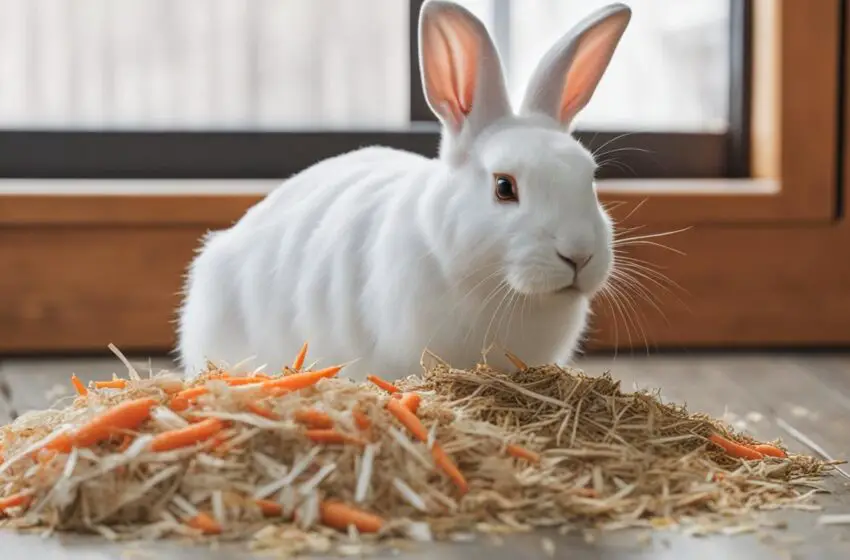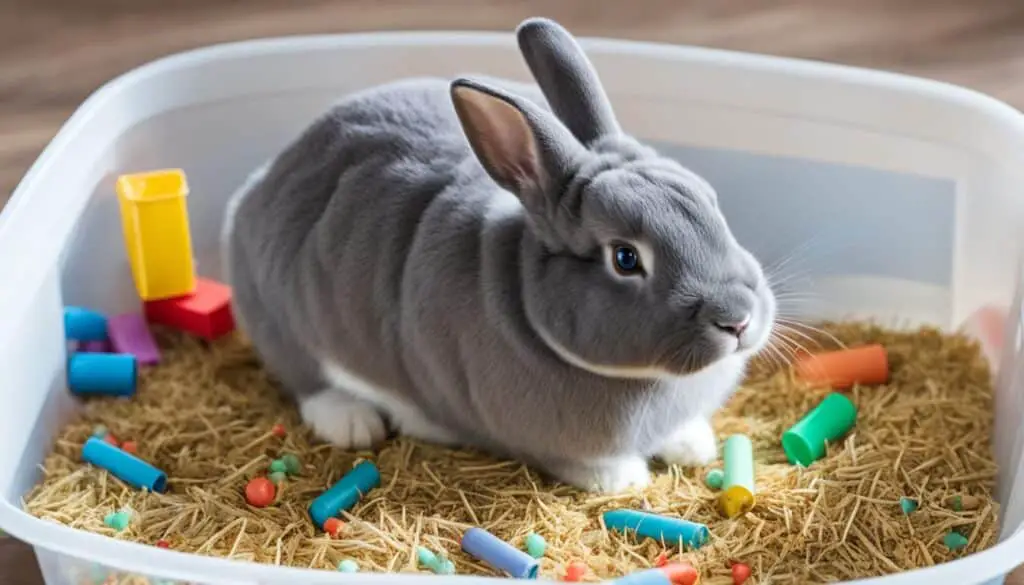Step-by-Step Guide to Rabbit Litter Training Techniques

Rabbit litter training is an essential aspect of pet care for bunny owners. By following a step-by-step guide, you can achieve a clean and comfortable habitat for your beloved pet. This article will outline various techniques and tips for successfully litter training your rabbit, ensuring a mess-free living space for both of you.
Key Takeaways:
- Proper rabbit litter training techniques are crucial for maintaining a clean habitat for your pet bunny.
- Understanding your rabbit’s behavior and preferences is essential before starting the litter training process.
- Choosing the right litter and litter box is crucial for successful litter training.
- Gradually introducing the litter box to your rabbit and providing positive reinforcement can help encourage litter box use.
- In case of any litter box problems, consult with a veterinarian to address any underlying health issues.
Understanding Rabbit Behavior and Preferences
Before starting the litter training process, it’s important to understand your rabbit’s behavior and litter box preferences. Rabbits are naturally clean animals that tend to eliminate waste in specific areas. They also have preferences for certain types of litter and litter box locations.
Observing your rabbit’s behavior can give you valuable insights into their litter training needs. Does your rabbit consistently use a specific corner to eliminate waste? Do they display signs of discomfort or anxiety in certain areas of their enclosure?
Similarly, rabbits may have preferences when it comes to litter materials. Some may prefer softer litters made of paper, while others may feel more comfortable with wood shavings. By understanding their preferences, you can create a litter box environment that encourages your rabbit to use it consistently.
Another important aspect to consider is the location of the litter box. Rabbits often feel safer and more secure in enclosed spaces. Placing the litter box in a quiet, low-traffic area of their enclosure can help them feel more at ease while using it.
By taking the time to observe your rabbit’s behavior and understand their litter box preferences, you can tailor your litter training approach to better meet their individual needs. This will greatly increase the chances of successful litter training.
Key Points:
- Rabbits have specific areas where they prefer to eliminate waste.
- They may have preferences for certain types of litter materials.
- Rabbits feel more secure in enclosed litter box locations.
“Understanding your rabbit’s behavior and preferences is essential for effective litter training.” – Dr. Jane Williams, Rabbit Care Specialist
Rabbit Behavior and Litter Box Preferences Table
| Behavior | Implication |
|---|---|
| Rabbits tend to eliminate waste in specific areas. | Provide a litter box in their preferred elimination spot. |
| Rabbits may have preferences for certain types of litter materials. | Offer a variety of litter options to determine their preference. |
| Rabbits feel more secure in enclosed litter box locations. | Choose a litter box with low sides or consider placing it in a discreet corner. |
Choosing the Right Litter and Litter Box
When it comes to successful litter training for your rabbit, choosing the right litter and litter box is essential. Rabbits have specific preferences and needs when it comes to their bathroom habits, and providing them with the appropriate materials and setup will greatly contribute to their comfort and ease of litter training.
Rabbits typically prefer soft, absorbent bedding materials for their litter. Paper-based litters or wood shavings are popular choices that provide a comfortable surface for your rabbit to walk on and absorb odor efficiently. Avoid using clumping cat litter, as it can be harmful to rabbits if ingested. Similarly, avoid using any aromatic options, as strong smells can be overwhelming for rabbits and discourage litter box usage.
In addition to choosing the right litter, selecting the proper litter box is equally important. Opt for a litter box that is large enough for your rabbit to comfortably enter and exit, with low sides for easy access. This will ensure that your rabbit can use the litter box comfortably without any difficulties or reluctance.
Remember, providing the right litter and litter box is crucial for a successful litter training experience. It will not only promote your rabbit’s well-being and hygiene but also facilitate a cleaner and more pleasant living environment for both of you.
Choosing the Right Litter and Litter Box – Summary
| Litter | Litter Box |
|---|---|
| Soft, absorbent bedding materials | Large enough for easy access |
| Examples: Paper-based litters, wood shavings | Low sides for comfort |
| Avoid clumping cat litter or aromatic options |

Choosing the right litter and litter box is crucial for successful litter training. Rabbits prefer soft, absorbent bedding materials such as paper-based litters or wood shavings. Avoid using clumping cat litter or aromatic options. Additionally, ensure that the litter box is large enough for your rabbit to enter and exit comfortably, with low sides for easy access.
Introducing the Litter Box to Your Rabbit
Introducing the litter box to your rabbit is an important step in their training process. By gradually acclimatizing them to the litter box, you can encourage proper litter habits and create a clean living environment. Here is a step-by-step guide on how to introduce the litter box to your rabbit:
- Choose a quiet area: Find a quiet area in your home where your rabbit spends most of their time. This will be the ideal location for placing the litter box.
- Place droppings in the box: Start by placing a few of your rabbit’s droppings inside the litter box. This will help them recognize the box as a familiar and appropriate spot for eliminating waste.
- Encourage investigation: Allow your rabbit to explore the box at their own pace. They may sniff, scratch, or even hop into the box out of curiosity. This is a positive sign that they are becoming comfortable with it.
- Reward with treats and praise: When your rabbit shows interest in the litter box or starts using it, reward them with small treats or verbal praise. This positive reinforcement will reinforce the desired behavior and make them more likely to use the box consistently.
- Repeat the process: Repeat this process consistently until your rabbit starts using the litter box on a regular basis. Be patient and continue to provide positive reinforcement.
Remember, every rabbit is unique, and it may take time for them to adjust to the litter box. Stay consistent, offer praise and treats, and be patient as you guide them through the training process.
Benefits of Gradual Litter Box Introduction
| Benefits | Description |
|---|---|
| Reduced stress | A gradual introduction helps decrease stress for your rabbit, as they can adapt to the litter box at their own pace. |
| Increased acceptance | By allowing your rabbit to investigate and become familiar with the litter box gradually, they are more likely to accept it as a regular part of their environment. |
| Positive reinforcement | The reward system during the introduction process helps reinforce the desired behavior of using the litter box. |
| Established routine | Through consistent introduction, your rabbit will develop a routine and understand that the litter box is where they should eliminate waste. |
Remember, patience and consistency are key when introducing the litter box to your rabbit. With time, they will learn to use the litter box consistently, resulting in a cleaner and healthier environment for both you and your pet.
Encouraging Litter Box Use
Once your rabbit starts using the litter box, it’s important to encourage and reinforce this behavior. Positive reinforcement plays a crucial role in establishing and maintaining proper litter box habits. Whenever you observe your rabbit using the box, provide positive reinforcement such as treats or verbal praise. This will create a positive association with the litter box and motivate your rabbit to continue using it.
Consistency is key when encouraging litter box use. Make sure to consistently reward your rabbit every time they use the box, especially during the initial stages of training. This will help reinforce the desired behavior and increase the likelihood of them using the litter box consistently.
Tip: Use small, rabbit-safe treats as a form of positive reinforcement. This can include fresh vegetables like cilantro or parsley.
Avoid punishing your rabbit for accidents outside the litter box, as this can create negative associations and hinder the training process. Instead, focus on providing positive reinforcement for correct litter box usage. If accidents occur, remain patient and clean up the mess without drawing attention to it or scolding your rabbit.
Remember, rabbits are intelligent animals and respond well to positive reinforcement. By consistently rewarding and praising your rabbit, you will encourage them to use the litter box and establish good habits.

Key Points:
- Encourage and reinforce litter box use with positive reinforcement such as treats and verbal praise.
- Consistency is important in establishing and maintaining proper litter box habits.
- Avoid punishing your rabbit for accidents outside the litter box.
- Provide consistent rewards and praise to motivate your rabbit to use the litter box consistently.
Addressing Litter Box Problems
Despite your best efforts, it is not uncommon for rabbits to encounter litter box problems during the training process. Some common issues include soiling outside the litter box or inconsistent use of the box. However, with appropriate troubleshooting techniques, you can help resolve these problems and ensure effective litter training for your rabbit.
Determining the Cause
When faced with litter box problems, it is essential to identify the underlying cause. Rabbits may exhibit such behavior due to various reasons, including:
- Health issues
- Anxiety or stress
- Unsuitable litter or litter box
- Territorial marking
By understanding the specific cause, you can tailor your troubleshooting approach and address the root of the problem more effectively.
Troubleshooting Techniques
Here are some troubleshooting techniques to address common litter box problems:
- Evaluate the litter box: Ensure that the litter box is clean, odor-free, and located in a quiet area. Rabbits are highly sensitive to smells, so maintaining cleanliness is crucial for their litter box habits.
- Introduce additional litter boxes: If your rabbit is consistently soiling outside the box, consider providing multiple litter boxes throughout their living space. This can increase accessibility and reduce accidents.
- Adjust litter type: Experiment with different types of litter to find the one that your rabbit prefers. Some rabbits may have specific preferences, such as paper-based litters or wood shavings.
- Implement positive reinforcement: Use positive reinforcement techniques to encourage your rabbit to use the litter box. Reward them with treats or verbal praise whenever they exhibit desired behavior.
- Consult a veterinarian: If your rabbit continues to have persistent litter box problems despite your efforts, it may be beneficial to consult a veterinarian. They can rule out any underlying health issues that could be contributing to the problem.
Remember, addressing litter box problems requires patience and consistent efforts. By troubleshooting the issue and implementing appropriate techniques, you can help your rabbit develop proper litter box habits.
| Common Litter Box Problems | Troubleshooting Techniques |
|---|---|
| Soiling outside the box | Evaluate cleanliness, introduce additional litter boxes, adjust litter type, reinforce proper behavior |
| Inconsistent use of the box | Evaluate cleanliness, adjust litter type, reinforce proper behavior, consult a veterinarian if necessary |
Conclusion
Litter training your rabbit is an essential aspect of pet care that contributes to a clean and comfortable habitat for both you and your furry friend. By understanding your rabbit’s behavior and preferences, choosing the right litter and litter box, gradually introducing the box, and providing positive reinforcement, you can successfully train your rabbit to use the litter box consistently.
Throughout the training process, it is important to be patient and consistent. Rabbits may take some time to adapt to the litter box, but with perseverance, they will develop proper litter box habits. Remember to reward your rabbit with treats or praise when they use the litter box correctly, as this positive reinforcement encourages desired behavior.
In the event of any issues or persistent litter box problems, it is advisable to consult with a veterinarian. They can rule out any potential health issues that may be affecting your rabbit’s litter box habits or provide further guidance on litter training techniques.
By employing these techniques and maintaining a clean litter box, you can ensure a mess-free living environment for both you and your pet bunny. A successfully litter-trained rabbit will contribute to a happier and healthier bond between you and your furry companion.
FAQ
Why is litter training important for rabbits?
Litter training is important for rabbits because it helps create a clean and comfortable habitat for both the rabbit and its owner.
How do I understand my rabbit’s behavior and preferences?
You can understand your rabbit’s behavior and preferences by observing where they eliminate waste and their preferred litter box locations.
What type of litter should I use for my rabbit?
Rabbits typically prefer soft, absorbent bedding materials such as paper-based litters or wood shavings. Avoid clumping cat litter or aromatic options as they can be harmful.
What should I consider when choosing a litter box for my rabbit?
Choose a litter box that is large enough for the rabbit to comfortably enter and exit, with low sides for easy access.
How do I introduce the litter box to my rabbit?
Start by placing the litter box in a quiet area where the rabbit spends most of its time. Encourage the rabbit to investigate the box by placing some of their droppings inside.
How can I encourage my rabbit to use the litter box?
Whenever you observe your rabbit using the litter box, provide positive reinforcement such as treats or verbal praise.
What should I do if my rabbit has accidents outside the litter box?
Ensure the litter box is clean and odor-free. If the problem persists, consult with a veterinarian to rule out any underlying health issues.



